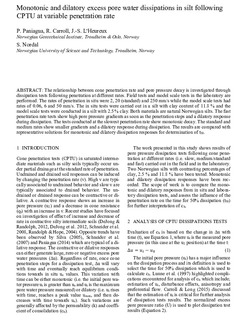| dc.contributor.author | Paniagua López, Ana Priscilla | |
| dc.contributor.author | Carroll, Roselyn | |
| dc.contributor.author | L'Heureux, Jean-Sébastien | |
| dc.contributor.author | Nordal, Steinar | |
| dc.date.accessioned | 2018-03-23T07:46:15Z | |
| dc.date.available | 2018-03-23T07:46:15Z | |
| dc.date.issued | 2016 | |
| dc.identifier.citation | 5th International Conference on Geotechnical and Geophysical Site Characterisation, ISC'5 Queensland, Australia | nb_NO |
| dc.identifier.uri | http://hdl.handle.net/11250/2491806 | |
| dc.description.abstract | The relationship between cone penetration rate and pore pressure decay is investigated through dissipation tests following penetration at different rates. Field tests and model scale tests in the laboratory are performed. The rates of penetration in situ were 2, 20 (standard) and 250 mm/s while the model scale tests had rates of 0.06, 6 and 50 mm/s. The in situ tests were carried out in a silt with clay content of 11.8 % and the model scale tests were conducted in a silt with 2.5 % clay. Both materials are natural Norwegian silts. The fast penetration rate tests show high pore pressure gradients as soon as the penetration stops and a dilatory response during dissipation. The tests conducted at the slowest penetration rate show monotonic decay. The standard and medium rates show smaller gradients and a dilatory response during dissipation. The results are compared with representative solutions for monotonic and dilatory dissipation responses for determination of t50. | nb_NO |
| dc.language.iso | eng | nb_NO |
| dc.title | Monotonic and dilatory excess pore water dissipations in silt following CPTU at variable penetration rate | nb_NO |
| dc.type | Chapter | nb_NO |
